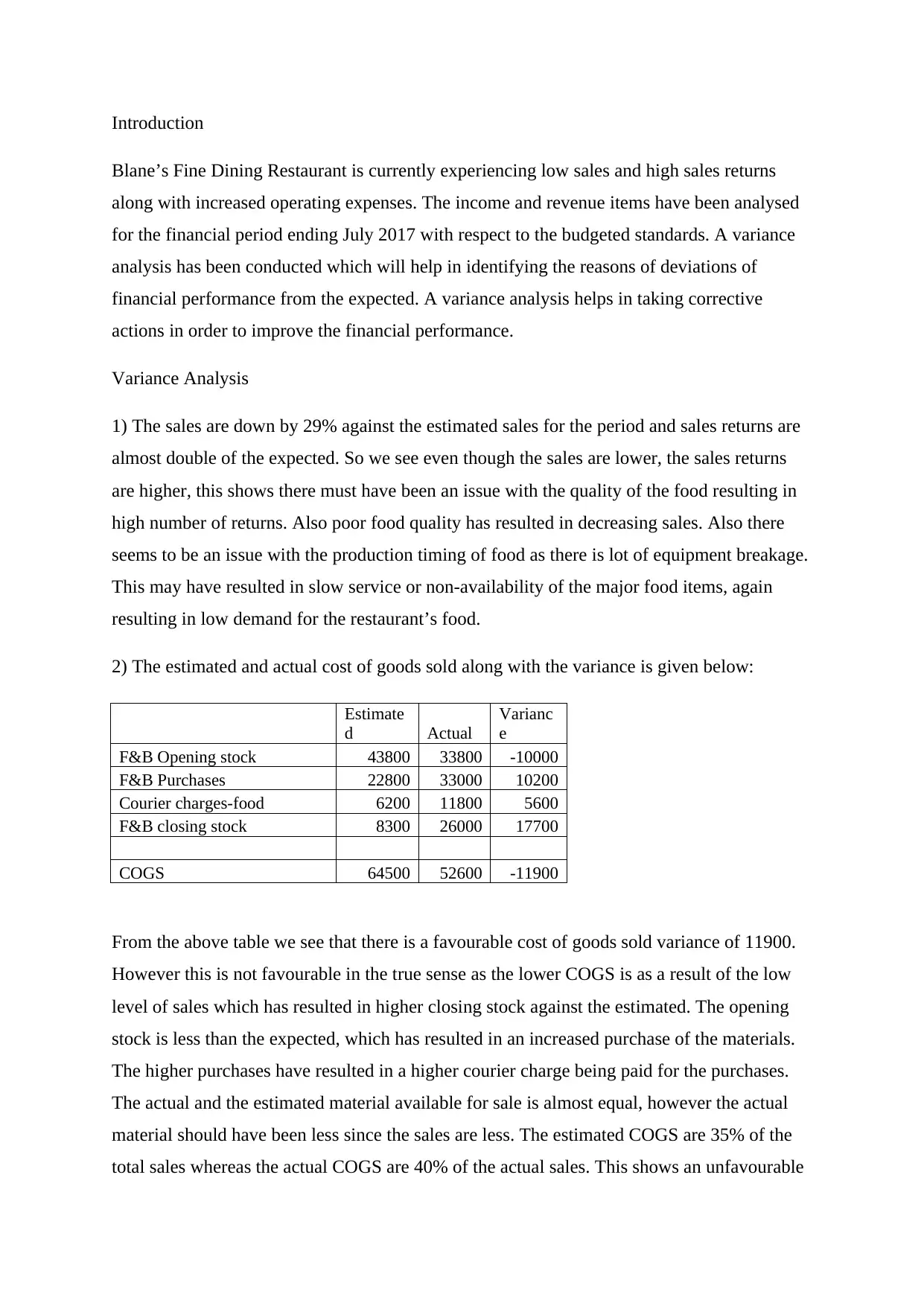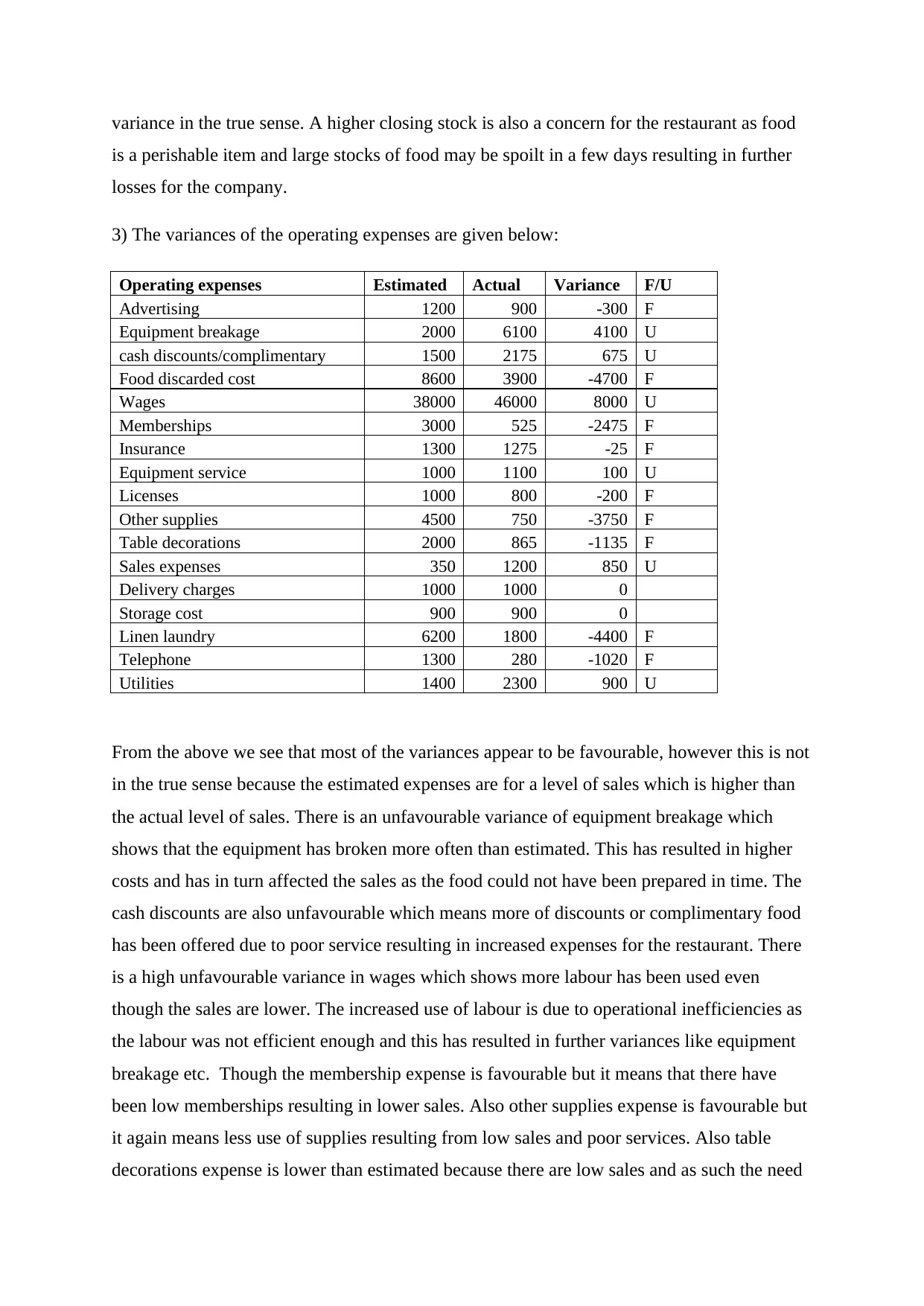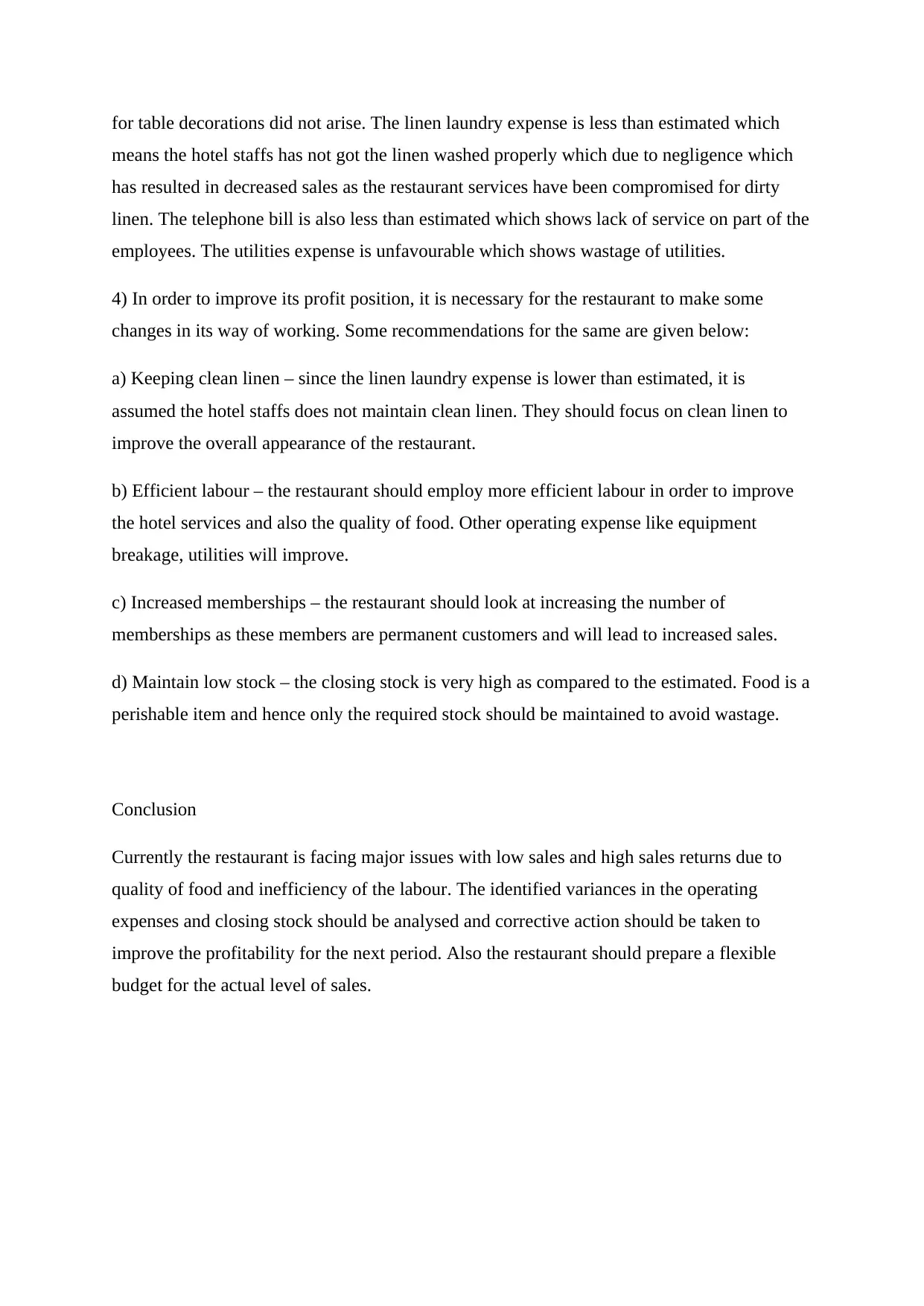Blane's Fine Dining Restaurant: Financial Variance Analysis Report
VerifiedAdded on 2020/05/11
|3
|1108
|235
Report
AI Summary
This report presents a variance analysis of Blane's Fine Dining Restaurant, focusing on the financial performance for the period ending July 2017. The analysis examines key areas including sales, sales returns, cost of goods sold, and operating expenses, comparing actual figures against budgeted standards. The report highlights significant variances, such as a 29% decrease in sales and increased sales returns indicating potential quality issues. It also investigates variances in the cost of goods sold and various operating expenses like equipment breakage, wages, and utilities. The analysis reveals that while some variances appear favorable, they are often a result of decreased sales. The report concludes with recommendations for improvement, including maintaining clean linen, employing efficient labor, increasing memberships, and managing inventory levels to reduce waste and enhance overall profitability. A flexible budget is also suggested for future financial planning.

Introduction
Blane’s Fine Dining Restaurant is currently experiencing low sales and high sales returns
along with increased operating expenses. The income and revenue items have been analysed
for the financial period ending July 2017 with respect to the budgeted standards. A variance
analysis has been conducted which will help in identifying the reasons of deviations of
financial performance from the expected. A variance analysis helps in taking corrective
actions in order to improve the financial performance.
Variance Analysis
1) The sales are down by 29% against the estimated sales for the period and sales returns are
almost double of the expected. So we see even though the sales are lower, the sales returns
are higher, this shows there must have been an issue with the quality of the food resulting in
high number of returns. Also poor food quality has resulted in decreasing sales. Also there
seems to be an issue with the production timing of food as there is lot of equipment breakage.
This may have resulted in slow service or non-availability of the major food items, again
resulting in low demand for the restaurant’s food.
2) The estimated and actual cost of goods sold along with the variance is given below:
Estimate
d Actual
Varianc
e
F&B Opening stock 43800 33800 -10000
F&B Purchases 22800 33000 10200
Courier charges-food 6200 11800 5600
F&B closing stock 8300 26000 17700
COGS 64500 52600 -11900
From the above table we see that there is a favourable cost of goods sold variance of 11900.
However this is not favourable in the true sense as the lower COGS is as a result of the low
level of sales which has resulted in higher closing stock against the estimated. The opening
stock is less than the expected, which has resulted in an increased purchase of the materials.
The higher purchases have resulted in a higher courier charge being paid for the purchases.
The actual and the estimated material available for sale is almost equal, however the actual
material should have been less since the sales are less. The estimated COGS are 35% of the
total sales whereas the actual COGS are 40% of the actual sales. This shows an unfavourable
Blane’s Fine Dining Restaurant is currently experiencing low sales and high sales returns
along with increased operating expenses. The income and revenue items have been analysed
for the financial period ending July 2017 with respect to the budgeted standards. A variance
analysis has been conducted which will help in identifying the reasons of deviations of
financial performance from the expected. A variance analysis helps in taking corrective
actions in order to improve the financial performance.
Variance Analysis
1) The sales are down by 29% against the estimated sales for the period and sales returns are
almost double of the expected. So we see even though the sales are lower, the sales returns
are higher, this shows there must have been an issue with the quality of the food resulting in
high number of returns. Also poor food quality has resulted in decreasing sales. Also there
seems to be an issue with the production timing of food as there is lot of equipment breakage.
This may have resulted in slow service or non-availability of the major food items, again
resulting in low demand for the restaurant’s food.
2) The estimated and actual cost of goods sold along with the variance is given below:
Estimate
d Actual
Varianc
e
F&B Opening stock 43800 33800 -10000
F&B Purchases 22800 33000 10200
Courier charges-food 6200 11800 5600
F&B closing stock 8300 26000 17700
COGS 64500 52600 -11900
From the above table we see that there is a favourable cost of goods sold variance of 11900.
However this is not favourable in the true sense as the lower COGS is as a result of the low
level of sales which has resulted in higher closing stock against the estimated. The opening
stock is less than the expected, which has resulted in an increased purchase of the materials.
The higher purchases have resulted in a higher courier charge being paid for the purchases.
The actual and the estimated material available for sale is almost equal, however the actual
material should have been less since the sales are less. The estimated COGS are 35% of the
total sales whereas the actual COGS are 40% of the actual sales. This shows an unfavourable
Paraphrase This Document
Need a fresh take? Get an instant paraphrase of this document with our AI Paraphraser

variance in the true sense. A higher closing stock is also a concern for the restaurant as food
is a perishable item and large stocks of food may be spoilt in a few days resulting in further
losses for the company.
3) The variances of the operating expenses are given below:
Operating expenses Estimated Actual Variance F/U
Advertising 1200 900 -300 F
Equipment breakage 2000 6100 4100 U
cash discounts/complimentary 1500 2175 675 U
Food discarded cost 8600 3900 -4700 F
Wages 38000 46000 8000 U
Memberships 3000 525 -2475 F
Insurance 1300 1275 -25 F
Equipment service 1000 1100 100 U
Licenses 1000 800 -200 F
Other supplies 4500 750 -3750 F
Table decorations 2000 865 -1135 F
Sales expenses 350 1200 850 U
Delivery charges 1000 1000 0
Storage cost 900 900 0
Linen laundry 6200 1800 -4400 F
Telephone 1300 280 -1020 F
Utilities 1400 2300 900 U
From the above we see that most of the variances appear to be favourable, however this is not
in the true sense because the estimated expenses are for a level of sales which is higher than
the actual level of sales. There is an unfavourable variance of equipment breakage which
shows that the equipment has broken more often than estimated. This has resulted in higher
costs and has in turn affected the sales as the food could not have been prepared in time. The
cash discounts are also unfavourable which means more of discounts or complimentary food
has been offered due to poor service resulting in increased expenses for the restaurant. There
is a high unfavourable variance in wages which shows more labour has been used even
though the sales are lower. The increased use of labour is due to operational inefficiencies as
the labour was not efficient enough and this has resulted in further variances like equipment
breakage etc. Though the membership expense is favourable but it means that there have
been low memberships resulting in lower sales. Also other supplies expense is favourable but
it again means less use of supplies resulting from low sales and poor services. Also table
decorations expense is lower than estimated because there are low sales and as such the need
is a perishable item and large stocks of food may be spoilt in a few days resulting in further
losses for the company.
3) The variances of the operating expenses are given below:
Operating expenses Estimated Actual Variance F/U
Advertising 1200 900 -300 F
Equipment breakage 2000 6100 4100 U
cash discounts/complimentary 1500 2175 675 U
Food discarded cost 8600 3900 -4700 F
Wages 38000 46000 8000 U
Memberships 3000 525 -2475 F
Insurance 1300 1275 -25 F
Equipment service 1000 1100 100 U
Licenses 1000 800 -200 F
Other supplies 4500 750 -3750 F
Table decorations 2000 865 -1135 F
Sales expenses 350 1200 850 U
Delivery charges 1000 1000 0
Storage cost 900 900 0
Linen laundry 6200 1800 -4400 F
Telephone 1300 280 -1020 F
Utilities 1400 2300 900 U
From the above we see that most of the variances appear to be favourable, however this is not
in the true sense because the estimated expenses are for a level of sales which is higher than
the actual level of sales. There is an unfavourable variance of equipment breakage which
shows that the equipment has broken more often than estimated. This has resulted in higher
costs and has in turn affected the sales as the food could not have been prepared in time. The
cash discounts are also unfavourable which means more of discounts or complimentary food
has been offered due to poor service resulting in increased expenses for the restaurant. There
is a high unfavourable variance in wages which shows more labour has been used even
though the sales are lower. The increased use of labour is due to operational inefficiencies as
the labour was not efficient enough and this has resulted in further variances like equipment
breakage etc. Though the membership expense is favourable but it means that there have
been low memberships resulting in lower sales. Also other supplies expense is favourable but
it again means less use of supplies resulting from low sales and poor services. Also table
decorations expense is lower than estimated because there are low sales and as such the need

for table decorations did not arise. The linen laundry expense is less than estimated which
means the hotel staffs has not got the linen washed properly which due to negligence which
has resulted in decreased sales as the restaurant services have been compromised for dirty
linen. The telephone bill is also less than estimated which shows lack of service on part of the
employees. The utilities expense is unfavourable which shows wastage of utilities.
4) In order to improve its profit position, it is necessary for the restaurant to make some
changes in its way of working. Some recommendations for the same are given below:
a) Keeping clean linen – since the linen laundry expense is lower than estimated, it is
assumed the hotel staffs does not maintain clean linen. They should focus on clean linen to
improve the overall appearance of the restaurant.
b) Efficient labour – the restaurant should employ more efficient labour in order to improve
the hotel services and also the quality of food. Other operating expense like equipment
breakage, utilities will improve.
c) Increased memberships – the restaurant should look at increasing the number of
memberships as these members are permanent customers and will lead to increased sales.
d) Maintain low stock – the closing stock is very high as compared to the estimated. Food is a
perishable item and hence only the required stock should be maintained to avoid wastage.
Conclusion
Currently the restaurant is facing major issues with low sales and high sales returns due to
quality of food and inefficiency of the labour. The identified variances in the operating
expenses and closing stock should be analysed and corrective action should be taken to
improve the profitability for the next period. Also the restaurant should prepare a flexible
budget for the actual level of sales.
means the hotel staffs has not got the linen washed properly which due to negligence which
has resulted in decreased sales as the restaurant services have been compromised for dirty
linen. The telephone bill is also less than estimated which shows lack of service on part of the
employees. The utilities expense is unfavourable which shows wastage of utilities.
4) In order to improve its profit position, it is necessary for the restaurant to make some
changes in its way of working. Some recommendations for the same are given below:
a) Keeping clean linen – since the linen laundry expense is lower than estimated, it is
assumed the hotel staffs does not maintain clean linen. They should focus on clean linen to
improve the overall appearance of the restaurant.
b) Efficient labour – the restaurant should employ more efficient labour in order to improve
the hotel services and also the quality of food. Other operating expense like equipment
breakage, utilities will improve.
c) Increased memberships – the restaurant should look at increasing the number of
memberships as these members are permanent customers and will lead to increased sales.
d) Maintain low stock – the closing stock is very high as compared to the estimated. Food is a
perishable item and hence only the required stock should be maintained to avoid wastage.
Conclusion
Currently the restaurant is facing major issues with low sales and high sales returns due to
quality of food and inefficiency of the labour. The identified variances in the operating
expenses and closing stock should be analysed and corrective action should be taken to
improve the profitability for the next period. Also the restaurant should prepare a flexible
budget for the actual level of sales.
⊘ This is a preview!⊘
Do you want full access?
Subscribe today to unlock all pages.

Trusted by 1+ million students worldwide
1 out of 3
Your All-in-One AI-Powered Toolkit for Academic Success.
+13062052269
info@desklib.com
Available 24*7 on WhatsApp / Email
![[object Object]](/_next/static/media/star-bottom.7253800d.svg)
Unlock your academic potential
Copyright © 2020–2025 A2Z Services. All Rights Reserved. Developed and managed by ZUCOL.
